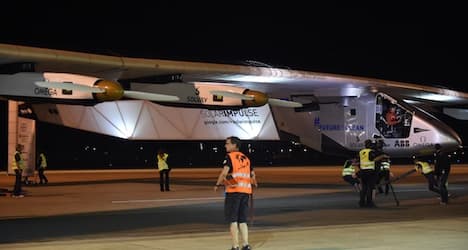Solar plane 'could remain stuck in Japan for a year'

A Swiss solar-powered plane attempting to fly
around the world must cross the Pacific within a few weeks or it could remain stuck in Japan for a year, the project's co-founder said in an interview published on Thursday.
Solar Impulse 2, which has been stranded in Japan for three weeks and had to postpone a planned take off this week due to bad weather over the Pacific, only has a short window for making the next leg of its journey, one of its two pilots, Bertrand Piccard, told the Tribune de Genève newspaper.
By early August, the days will become too short for the solar-driven plane to cross the Pacific, and subsequently the Atlantic Ocean safely, he said.
"Before August 5th, we must have crossed the Pacific or the Atlantic," Piccard said, adding that if the team is unable to do so they will have to find a permanent hangar where the fragile aircraft can pass the winter.
If the plane makes it to the United States, it can easily pass the winter there before crossing the Atlantic to complete its around-the-world trip, since the team has a permanent hanger in New York, Piccard said.
His partner, André Borschberg, had been scheduled to take off with the plane from the central Japanese city of Nagoya early Wednesday bound for Hawaii, on the latest and most ambitious leg of a bid to circumnavigate the
globe using only power from the sun.
But after a few agonizing hours poring over meteorological forecasts covering the five days and five nights the flight was expected to take, mission chiefs pulled the plug.
"There is still a cold front that is blocking our route," Piccard said.
"Our meteorologists are constantly evaluating alternative routes."
Solar Impulse 2 can "fly through clouds for ten hours, but after that it needs blue skies to recharge its batteries," Piccard said.
"Otherwise, André will have to jump out in a parachute. We can't take that risk."
The featherweight flying machine was not supposed to land in Japan on its multi-leg trip around the globe, but bad weather en route from Nanjing, China to Hawaii forced a diversion at the start of June.
Ever since, the crew has been scouring long-range forecasts for an opportunity to restart its record-breaking journey.
Piccard said the many sponsors footing the bill for the project had promised to continue their support, but acknowledged the team would need to figure out how to continue paying salaries to the some 150 people working on the venture if it dragged on.
Comments
See Also
Solar Impulse 2, which has been stranded in Japan for three weeks and had to postpone a planned take off this week due to bad weather over the Pacific, only has a short window for making the next leg of its journey, one of its two pilots, Bertrand Piccard, told the Tribune de Genève newspaper.
By early August, the days will become too short for the solar-driven plane to cross the Pacific, and subsequently the Atlantic Ocean safely, he said.
"Before August 5th, we must have crossed the Pacific or the Atlantic," Piccard said, adding that if the team is unable to do so they will have to find a permanent hangar where the fragile aircraft can pass the winter.
If the plane makes it to the United States, it can easily pass the winter there before crossing the Atlantic to complete its around-the-world trip, since the team has a permanent hanger in New York, Piccard said.
His partner, André Borschberg, had been scheduled to take off with the plane from the central Japanese city of Nagoya early Wednesday bound for Hawaii, on the latest and most ambitious leg of a bid to circumnavigate the
globe using only power from the sun.
But after a few agonizing hours poring over meteorological forecasts covering the five days and five nights the flight was expected to take, mission chiefs pulled the plug.
"There is still a cold front that is blocking our route," Piccard said.
"Our meteorologists are constantly evaluating alternative routes."
Solar Impulse 2 can "fly through clouds for ten hours, but after that it needs blue skies to recharge its batteries," Piccard said.
"Otherwise, André will have to jump out in a parachute. We can't take that risk."
The featherweight flying machine was not supposed to land in Japan on its multi-leg trip around the globe, but bad weather en route from Nanjing, China to Hawaii forced a diversion at the start of June.
Ever since, the crew has been scouring long-range forecasts for an opportunity to restart its record-breaking journey.
Piccard said the many sponsors footing the bill for the project had promised to continue their support, but acknowledged the team would need to figure out how to continue paying salaries to the some 150 people working on the venture if it dragged on.
Join the conversation in our comments section below. Share your own views and experience and if you have a question or suggestion for our journalists then email us at [email protected].
Please keep comments civil, constructive and on topic – and make sure to read our terms of use before getting involved.
Please log in here to leave a comment.